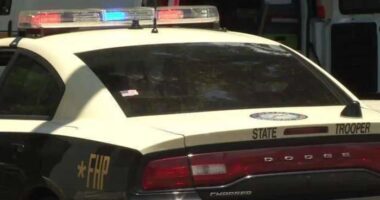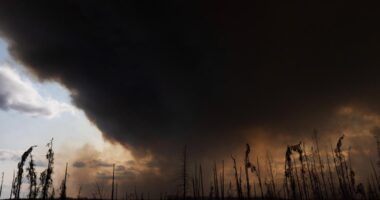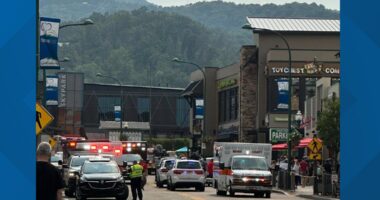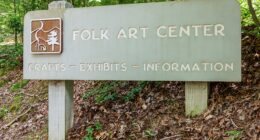DENVER — As Donald Trump’s presidential campaign shone a national spotlight on Colorado’s gang activity, some viral videos and local politicians are raising concerns that newcomers are bringing new violence. But a Denver7 in-depth look at the state’s gang history shows the issue is mostly homegrown and deeply rooted.
Denver7 sat down with police officers, criminologists and community leaders to learn how Colorado’s gangs, and the tactics for stopping them, are evolving over time — and why the current presence of immigrant-run gangs isn’t as alarming as some believe.
“If you look at the gang history here in Denver, this isn’t a one-off,” said Sgt. Damon Bowser, who supervises the Denver Police Department’s Special Operations Response Team, formerly known as the Gang Unit.

Drew Smith, Denver7
“We see groups pop up,” Sgt. Bowser said. “Mostly local, homegrown youth.”
Local police departments typically don’t talk about these gangs by name to avoid giving them notoriety and prevent copycats, he said.
Sgt. Bowser said gangs used to be easy to spot because they wore identifiable colors, flashed symbols, spray-painted tags and hung around specific neighborhoods. But gangs today are less obvious in their appearance and behavior, and law enforcement agencies no longer focus on broadly identifying gangs.
“It’s not explicitly illegal to be in a gang,” he said.
But gang members pop onto the police department’s radar when they commit crimes.
When it comes to immigrant youth committing gang-motivated crimes, “most of those residents arrived here in a lower socio-economic position, and kind of disadvantaged, as far as home security, food insecurity,” Sgt. Bowser explained. “If you look at our homegrown gangs, that’s the same population.”
Sgt. Bowser said it’s now well-accepted that poor economic conditions allow gangs to flourish, but the Denver Police Department didn’t consider those dynamics until recently.

Denver Police Department, Dieter Spears, Epic Photo Group
“It was strictly enforcement,” he said. “Jailing people again and again and again and again, and we ended up really reinforcing a lot of those negative cultures, because we became their antithesis.”
Today, the Denver Police Department is making a “really huge shift” when it comes to investigating gangs, Sgt. Bowser said.
“As we become more and more aware of the culture around crimes, and the way it affects the community, and the way it affects the families of victims, but also of the offenders,” the police department is engaging more with the community to prevent crimes, Sgt. Bowser said.
But to understand how Denver got here, we need to look back in time.
Colorado’s gang history traces back to the late 1800s, when roving criminals formed outlaw gangs to ambush, rob and at times murder people in the “Wild West.”

Fort Worth Five Photograph
From those early days to now, many criminal groups form in response to feeling unsafe, a desire to acquire status and an opportunity to make money with a group of people you believe you can trust, said David Pyrooz, criminologist at the University of Colorado Boulder.
“Gangs are as American as apple pie,” Pyrooz said. But the gangs evolved over time.
“The dynamics of gangs change with the flow of immigration to the United States, as well as the change in migration within the United States,” Pyrooz said.
As European settlers came to Denver in the late 1800s and early 1900s, gangs formed across ethnic lines, with “fights between Germans and Polish people, Jewish people, Italian, Irish,” Pyrooz said.

Denver Post
Since then, gangs — and law enforcement responses to them — have historically been shaped along racial and ethnic lines, said Robert Durán, criminologist at the Texas A&M University.
Durán briefly joined a gang as a teenager and now studies the reasons why gangs form. He researched Denver’s gang history for his book “Gang Life in Two Cities: An Insider’s Journey.”
As the Denver area urbanized and grew, and people of other ethnicities moved in, many different iterations of gangs emerged, Durán said.
By the 1920s, the Ku Klux Klan took political control over Colorado. The white supremacist secret society espoused hate against certain groups, such as immigrants, Catholics and Jews. The Klansmen ranks included prominent figures like Colorado Gov. Clarence Morley and Denver Mayor Benjamin Stapleton, who appointed a Klansman as chief of police in Denver.

Denver Public Library
The Klan’s rise to prominence coincided with more people of Mexican descent moving north from New Mexico and southern Colorado into the Denver area, making them a focus of law enforcement crackdowns.
“Moral panics have been used at different times to target populations,” including Latino, Black and Native American communities, Durán said. “Being marginalized in society, those are the groups that are often able to be scapegoated and targeted.”
Denver’s first documented “war on gangs” started in the 1940s and focused on Mexican Americans, Durán said. It was the Zoot Suit era, and police officers arrested Latino youth for crimes like loitering, drunkenness and vagrancy, mainly identifying “hoodlums” by their flashy suits and baggy pants.
The gangs formed in Denver in the 1940s and 50s were largely a response to marginalization, poor living and working conditions and discrimination by those in power, Durán said.
But by the 1960s and 70s, gangs nearly faded away, as Latino and Black youth were instead drawn into civil rights activism.

Juan Espinosa Collection at History Colorado
Law enforcement repression of activist groups like the Crusade for Justice and the Black Panthers however, eventually led to the demise of the movement.
Gangs soon came back with a vengeance by the late 1980s.
“Crips on the Eastside. Bloods on Park Hill,” said Reverend Leon Kelly, who leads Denver’s longest-standing anti-gang program, Open Door Youth Gang Alternatives.
As gang culture, and some gang members, from California came to Colorado, “I started to see the mindsets getting more aggressive,” Rev. Kelly said.

Drew Smith, Denver7
“Communities were demanding that the city do something,” he said. “Suppress it, take care of it, make it go away.”
Rev. Kelly’s Open Door program tried using intervention, “getting in and trying to defuse things.” The local police departments focused on arresting and jailing as many gang members as possible.
But “sometimes they come back worse than they went in” and violent crime continued, he said.
Local
30 years later: Revisiting Denver’s deadly ‘Summer of Violence’
In the decades since Colorado’s gang violence spiked, Rev. Kelly has seen many enforcement tactics fail, as conditions fueling gangs — such as poverty, a lack of positive male role models and discrimination in the criminal justice system — go unchanged.
Rev. Kelly keeps a “death book” of all of the youth his community has lost to gang violence, and the list is still growing.
“Seeing these kids land on these slabs that I’ve worked with, I’ve nurtured, I’ve tutored, I’ve loved, and now they on the slab,” he said. “It takes its toll.”
Nowadays, Rev. Kelly said his group has “switched up and started dealing with prevention.”
“Much easier to mold, to build a kid than to repair an adult,” he said.
Denver
Denver mayor announces new initiatives to prevent youth violence over the summer
In Denver and neighboring cities like Aurora, violence prevention programs are showing promise, said Pyrooz, the CU Boulder criminologist.
Pyrooz led a scientific study of Denver’s Office of Community Violence Solutions, previously known as the Gang Reduction Initiative of Denver (GRID). Denver created the program in the aftermath of the 2007 deadly drive-by shooting of Broncos cornerback Darrent Williams.
This central hub was intended to bring together Denver’s agencies, nonprofits and community groups to intervene, prevent and enforce against gangs. The program hires street outreach workers, mainly former gang members, who help youth follow a plan to stop engaging in violence.
“When we evaluated this program, we did, lo and behold, [find] it reduced the perpetration of violence among these kids by 70%,” Pyrooz said.
In Aurora, Standing Against Violence Every Day (SAVE), also “departs strongly from business as usual in the city where it was a Gang Unit arrest, incarcerate response,” Pyrooz said.
“If that’s the law enforcement providing the stick, then you have community members and outreach organizations who are providing the carrot,” he said.

City of Aurora
But even with these new approaches showing early success, the dynamics of gangs in the Denver metro area are changing, presenting new challenges.
Sgt. Bowser of the Denver Police Department said officers are now seeing more “young hybrid gangs.”
“Children — and we’ll call them children, that’s what they are — they feel pressure to create an online identity… someone who isn’t to be messed with,” Sgt. Bowser said. “They don’t have predicate crimes. They literally go from having no criminal history at all to doing a shocking violent crime against persons.”

Grand Theft Auto
Lt. Kevin Carroll, who also works with the Denver Police Department and collaborates with federal and local law enforcement agencies through the Regional Anti-Violence Enforcement Network (R.A.V.E.N.), said these hybrid gangs rely heavily on social media.
“It’s a lot of selling and buying firearms through the internet, through Facebook Marketplace,” Lt. Carroll said.
At younger ages, children are forming these pop-up gangs to commit violent crimes like those seen in the video game Grand Theft Auto, Lt. Carroll said.
A lot of these gang-motivated crimes — possession of illegal guns, armed robberies, aggravated assaults — end up under investigation by the regional task force, he said.
Currently, Lt. Carroll said R.A.V.E.N. is teaming up to investigate the recent concerns in Aurora over potential presence of the Venezuelan gang Tren de Aragua.
Aurora
What is Tren de Aragua? The gang’s history, from Venezuela’s prisons to US soil
“We’re certainly monitoring it, and we’re certainly putting a lot of resources to it, just to make sure it’s nothing that gets away from us,” said Sgt. Bowser.
But immigrant gangs really can’t take hold here, he said.
Denver has dealt with Central American gangs like MS-13 and southeast Asian gangs like Viet Pride in the past.
“A lot of those other countries, their criminal justice system is extremely compromised,” Sgt. Bowser said.
But here, complaints from victims of crimes are treated seriously and investigated.
“Any kind of criminal element that comes from another culture that expects to be able to establish a foothold and to begin to dictate the way things are going to go,” are stopped short by law enforcement, Sgt. Bowser said.
It’s hard to estimate how many gangs might be in Colorado though. Starting in the late 1980s, the Colorado Bureau of Investigations (CBI) kept a database of suspected gangs and gang members. That list estimated Colorado had roughly 110 street gangs and more than 12,000 gang members statewide in 2007. But lists like these came into question. In the early 2000s, the ACLU sued the Denver Police Department over its “vague, unreliable and subjective” intelligence-gathering guidelines which resulted in large swaths of young males of color getting added to the list regardless of whether they were actually affiliated with a gang or engaging in crimes.
Currently, there is no such database for tracking gang presence in the state, a CBI spokesperson told Denver7.
Sgt. Bowser said right now, many in Colorado “feel generally less safe” and “a lot of people are armed.” But the perception that immigrants are committing more crimes than US-born citizens is proven false by multiple studies.
Overall, gun violence is down 12% in Denver this year compared to last. This follows a nationwide trend of reduction after gun violence reached a historic high during the COVID-19 pandemic, according to crime data recently provided by the Denver Police Department to the City Council.
Denver
Denver violent gun crime is down but residents say they still don’t feel safe
When immigrant gang members do commit crimes, “criminals, gang or not, tend to prey on people from their own socio-economic status, and a lot of times from their own race,” Sgt. Bowser said.
When it comes to fears that Aurora apartment complexes are being taken over by gangs, those concerns are nothing new, said Rev. Kelly, whose anti-gang group faced similar concerns back in the 1980s.
“Who would have thought that decades later, the same concept, the same things were starting to happen,” Rev. Kelly said. “Is it a city that’s being overran and taken over by gangs? No, it is no different than what it was in the ‘80s.”
Aurora
Immigrants in CO ‘harmed’ by national attention on Tren de Aragua, activists say
It’s also unclear whether the alleged Venezuelan gang members in Aurora are affiliated with Tren de Aragua.
“Gangs tend to take on the names, the symbols, the signs of the most intimidating groups that are out there,” criminologist Pyrooz said.
Some immigrant youth coming from Venezuela might see claiming membership in Tren de Aragua as an easy way to gain status or acculturate quicker, Pyrooz said.
While “local communities can’t set federal policy” and make “determinations as to who enters into our country,” Pyrooz said places like Denver and Aurora can help give immigrant youth opportunities to prevent them from resorting to gangs.
“That puts the burden on our schools, on our communities, on our after-school activities,” he said. “We have to make sure that our immigrants over here ultimately get integrated and to do so successfully.”
Editor’s Note: Denver7 360 | In-Depth explores multiple sides of the topics that matter most to Coloradans, bringing in different perspectives so you can make up your own mind about the issues. To comment on this or other 360 In-Depth stories, email us at [email protected] or use this form. See more 360 | In-Depth stories here.

















